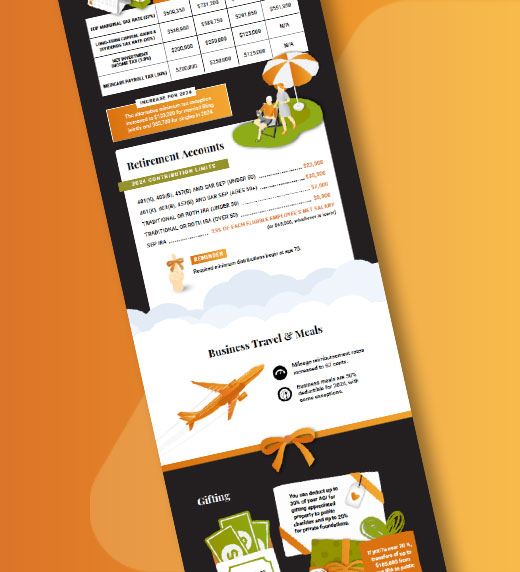
Coordinating an effective tax strategy can be intimidating, especially for business owners and other high-net-worth individuals. With so many moving parts, it's hard even to know where to begin — but the potential tax savings at stake make a strategic approach to year-end tax planning imperative. Ignoring this fundamental financial responsibility could mean missed opportunities for tax savings that can cost you tens of thousands of dollars or more.
The good news is that by working with a seasoned tax professional and giving yourself adequate lead time, effective tax planning doesn't have to be burdensome. You can claim more of the tax savings you're entitled to if you focus on these 12 key year-end tax tasks during the fourth quarter. However, waiting until the last minute can be an expensive mistake. The earlier you start, the more options you and your tax advisor will have to minimize your 2023 tax bill.
Gauge personal income and business revenue. Estimating year-end figures helps your tax advisor see where you'll fall relative to tax brackets, benefit phaseouts and relevant thresholds. Year-end projections allow business owners to determine how much executive compensation to draw. These projections also allow time to tweak the final numbers by pushing out revenue, making capital investments, prepaying predictable expenses and strategically timing staff bonuses, among other tactics. For executives, the rough numbers can help define your charitable donation strategy for the year and influence the timing of activities that carry tax consequences, such as real estate acquisitions.
Consider a Roth IRA conversion. Business owners and executives alike can use year-end estimates to assess the wisdom of a potential Roth conversion. Moving funds from a traditional IRA to a Roth account triggers additional taxes now, but the long-term benefits can be well worth the immediate tax hit in some scenarios. Your tax advisor will evaluate portfolio performance in the context of your other financial facts and overall tax situation to determine whether and when a Roth conversion makes sense for you.
Optimize retirement contributions for 2023. Business owners should rely on preliminary estimates of annual net revenue to inform decisions about 401(k) contributions and other tax-advantaged retirement accounts. Some of these funds must be deposited by December 31. However, you may be able to make additional contributions after the year-end for certain types of accounts and contributions, such as employer contributions to a solo 401(k). Adjusting contributions within the legal limits can help ensure your business and personal incomes fall within a targeted range.
Evaluate job-based benefits options for 2024. Your choices during open enrollment help shape your tax scenario for the upcoming year. Your tax advisor can help you set retirement contribution levels and make benefit selections that support your overall tax picture based on estimates of your anticipated income and deductions next year. Also, consider your treatment of restricted stock options, and evaluate the role that company stock plays on your personal balance sheet; too much concentration creates unnecessary risk. And while you're thinking about job-based benefits, remember to spend the full balance left in a Flexible Spending Account, as you'll lose any unused funds on January 1.
Remember to take required minimum distributions (RMDs). If you've reached retirement age, be sure to withdraw the full RMD from affected accounts by the end of the year. With your advisor, explore the potential utility of making a qualified charitable distribution from an IRA as an alternative to taking an RMD. If you have inherited retirement accounts, you may need to take an RMD at any age. You must also establish a separate account for each beneficiary by December 31 of the year following the original account owner's death because the RMDs for these accounts are based on life expectancy, so the appropriate distribution varies by owner.
Think through your gifting goals. The gift tax exclusion is $17,000 for 2023. While that's not a huge amount, you and your spouse can make any number of gifts at or under the exclusion limit. That means you and your spouse could each give $17,000 to each of your children, their spouses and their children in 2023. While you won't be passing the bulk of your estate this way, if you use the gift tax exclusion strategically and consistently, you can get a head start on transferring wealth to the next generation.
Refine your approach to charitable donations. Which charities are at the top of your list this year? Think about this question now so your advisor can determine the best giving strategy to maximize the tax benefit of your generosity. That could mean using a donor-advised fund (DAF), a financial vehicle that can deliver huge value to recipient organizations while providing tax benefits to you as a donor. A DAF costs far less to manage than a private foundation but still allows you to retain strong controls over the timing, triggers and purpose of your gifts.
Review your eligibility for tax credits. Your advisor should review credits and deductions that could potentially apply to you and verify your eligibility, along with deadlines and special requirements. That includes the tax implications of your business structure (e.g., qualified business deductions and rules for pass-through entities) as well as sunsetting legislation, new R&D rules and other regulatory changes.
Check your records. Reviewing financial accounting and files can reassure your CPA and help you avoid unpleasant surprises as the year draws to a close. A quick review now saves time and stress later by ensuring that you have adequate records to support all of the tax credits and deductions you'll claim on your business and personal returns this year. Remember, if you can't document, you can't deduct. Do it early so your tax advisor can compare preliminary 2023 numbers to earlier projections. If there's a discrepancy, you need time to implement a tax-efficient solution addressing the variation from expected income and deductions.
Look beyond federal tax obligations. Understanding the international and state and local taxes that may apply to you and/or your business is crucial. Global investments and assets can create additional tax complexity, including issues related to foreign income, foreign tax credits and compliance with international tax treaties. At the state and local level, personal income tax and business levies, such as a general corporation tax, can dramatically increase your total tax liability. With advance planning, a highly qualified tax advisor can help you proactively address these liabilities and incorporate them into a comprehensive tax strategy for maximum savings.
Plan for the future of your business. What can you do now to facilitate your exit later? Succession planning is most effective when it begins years or even decades before you transition out of the business. By taking certain steps, such as establishing key person insurance now, you can prepare well for a future exit scenario and potentially lower your business tax liability today. This deductible expense not only protects the company, but if structured properly, it can also help future leaders build the assets they'll need to buy you out. Depending on your industry, there may be other steps to take. For example, auto dealers can achieve a similar goal by establishing their own reinsurance companies that accumulate wealth to help their children or other future owners fund the transition once they're ready to take over the reins.
Focus on the big picture. For high-net-worth individuals and business owners, minimizing tax liability is a complex endeavor that demands extraordinary expertise. Tax loss harvesting in taxable brokerage accounts is an important component of your year-end planning, but it's only a beginning. Like strategic tax considerations for a privately held business, the unique tax rules and reporting requirements around alternative investments and complex investment portfolios require active management and awareness by a tax professional with specialized skills and knowledge.
These 12 tax tips can dramatically lower your tax bill not just this year but in years to come. However, a fully developed tax strategy involves much more than a checklist. The right advisor can help you take full advantage of tax saving opportunities while remaining fully compliant with all applicable tax authorities, but ultimately, their results depend on you.
Getting the most value from your advisory relationship depends on open lines of communication and regular check-ins, so your tax professional has the information they need to deliver the best results for you. Year-end planning yields peak savings when it's truly “all-year planning” that evolves through ongoing communication between you and your advisor.
Find out what your tax advisor needs now to ensure timely compliance and help you land on the sweet spot in your tax return — and, more importantly, to incorporate the myriad elements of your financial world into a cohesive strategy that yields maximum long-term tax savings.
It's also vital that you select a tax professional who brings high-level skills and experience to effectively manage the complexities of your tax situation. Besides technical expertise, a true tax pro prioritizes your unique goals, family dynamics, business activities and risk tolerance, crafting a comprehensive and nuanced financial strategy.
Are you paying more tax than you owe? As a business owner or highly compensated professional, you may be missing opportunities in your tax planning. With over 200 tax planning experts, we can help you find tax savings and stop leaving money on the table. Reach out to Armanino's tax planning experts today to learn how year-end tax planning can help you achieve personal, business and legacy goals.


